(完整word版)初中英语介词用法详解与练习
初中英语介词专项讲解及练习(包含答案)
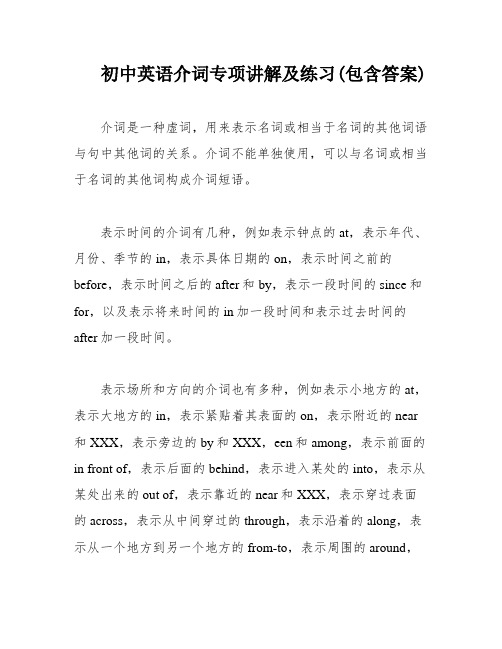
初中英语介词专项讲解及练习(包含答案)介词是一种虚词,用来表示名词或相当于名词的其他词语与句中其他词的关系。
介词不能单独使用,可以与名词或相当于名词的其他词构成介词短语。
表示时间的介词有几种,例如表示钟点的at,表示年代、月份、季节的in,表示具体日期的on,表示时间之前的before,表示时间之后的after和by,表示一段时间的since和for,以及表示将来时间的in加一段时间和表示过去时间的after加一段时间。
表示场所和方向的介词也有多种,例如表示小地方的at,表示大地方的in,表示紧贴着其表面的on,表示附近的near和XXX,表示旁边的by和XXX,een和among,表示前面的in front of,表示后面的behind,表示进入某处的into,表示从某处出来的out of,表示靠近的near和XXX,表示穿过表面的across,表示从中间穿过的through,表示沿着的along,表示从一个地方到另一个地方的from-to,表示周围的around,表示正上方的over,表示正下方的under,表示斜上方的above,表示斜下方的below。
介词的使用需要根据具体情况来判断,掌握介词的用法可以帮助我们更准确地表达自己的意思。
In using a language。
it'XXX to know about the culture and customs of the people you are XXX my experience。
as someone who has lived in different countries。
it's important to adapt and be respectful。
just like you would in your own country.With the right clothing and knowledge。
you can XXX。
(完整word版)初中介词(表时间地点介词)讲解练习及答案.doc
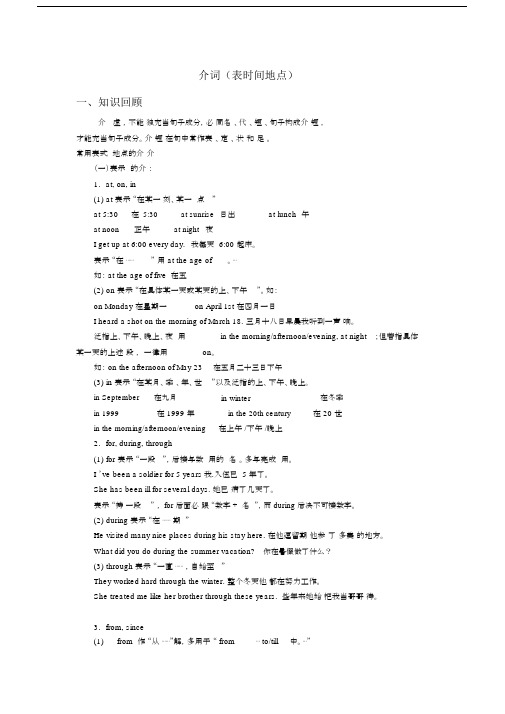
介词(表时间地点)一、知识回顾介虚,不能独充当句子成分,必同名、代、短、句子构成介短,才能充当句子成分。
介短在句中常作表、定、状和足。
常用表式地点的介介(一)表示的介:1. at, on, in(1)at 表示“在某一刻、某一点”at 5:30 在5:30 at sunrise 日出at lunch 午at noon 正午at night 夜I get up at 6:00 every day.我每天6:00起床。
表示“在⋯⋯” 用at the age of。
⋯如: at the age of five 在五(2)on 表示“在具体某一天或某天的上、下午”。
如:on Monday 在星期一on April 1st 在四月一日I heard a shot on the morning of March 18. 三月十八日早晨我听到一声响。
泛指上、下午、晚上、夜用in the morning/afternoon/evening, at night;但若指具体某一天的上述段,一律用on。
如: on the afternoon of May 23在五月二十三日下午(3)in 表示“在某月、季、年、世”以及泛指的上、下午、晚上。
in September 在九月in winter 在冬季in 1999 在 1999 年in the 20th century 在 20 世in the morning/afternoon/evening 在上午 /下午 /晚上2. for, during, through(1)for 表示“一段”,后接与数用的名。
多与完成用。
I ’ve been a soldier for 5 years我.入伍已 5 年了。
She has been ill for several days. 她已病了几天了。
表示“持一段” , for 后面必跟“数字 +名”,而 during 后决不可接数字。
(完整word)初中英语介词讲解

初中英语介词讲解1.介词的含义,介词(虚词),不能在句子中独立充当成分。
它总是用于名词、代词、或相当于名词的其它词类或短语活从句前。
中考需要掌握的11个介词:in、on、at、to、from、by、with、for、about、after、before表示时间的介词A.典型例题:1.in 1996 / in 2002 / in 1847(年份)2.in October / in February / in March (月份)3.in spring / in summer / in autumn / in winter (季节)4.in a week / in a year 在1周/ 年中5.in the morning / in the afternoon / in the evening 在上午/ 下午/ 晚上in those days 在当时/ in no time 立刻/ in the daytime 在白天/ in the future 在将来/ in one minute 在1分钟内/ 最后in the end表示较长时间(长于一天或短于一天)如:年、年份、月份、季节、周、上午、下午、晚上以及一些习惯用法中要用介词“in”。
-------------------------------------------------------------------------------------------------------------------------------- B.典型例题:1.at ten o’clock / at seven thirty. (表示某一钟点)2.at noon / at night / at midnight (在中午、晚上、半夜――一天中相对短暂的时间)3.at the age of twenty / at the age of thirty-five (表示某一年龄)4.at that time 在那时/ at the moment 这时、那时、此刻/ at first 首先/ at last 最后=in the end/ at once 立刻、马上/ at / on (the) weekends 在周末/ 在一年中的这个时候at this time of year / 在……开始/结束时at the beginning /end of表示时间的某一点(或表示某时刻)如:钟点、年龄或其它的习惯用法中要用“at”。
介词in,on,at及其练习附答案(解析版)

介词in,on,at及其练习附答案(解析版)介词in、on和at在表示时间的名词前的使用有所不同。
具体区别如下:一、使用in的情况:1.表示“在某年/月/季节”时,需要使用介词in。
例如:她于1980年来到这个城市。
夏天这里经常下雨。
2.表示“从现在起一段时间以后”时,需要使用介词in。
例如:他们将在一周后去看望你。
我将在一个月后回来。
3.表示“在某个世纪”时,需要使用介词in。
例如:这台机器是在18世纪发明的。
20世纪发生了巨大变化。
4.表示“在某个年代或特定世纪某个年代”时,需要使用介词in。
例如:该事件发生在20世纪70年代。
抗日战争爆发于20世纪30年代。
5.除此之外,morning、evening和afternoon三个词也常与介词in连用。
例如:晚上看电视不要太多。
他们有时在下午做游戏。
二、使用on的情况:1.表示“在具体的某一天”或“(在具体的某一天的)早上、中午、晚上”等,需要使用介词on。
例如:杰克生于1982年5月10日。
他们是在一个雨天的早上离开的。
他于一个夏天的下午返回了美国。
2) 表示星期几或其时间,需使用介词on。
例如:我们星期六和星期天不上学。
平日你几点起床?我是在星期六的早晨听到这个故事的。
3) 表示某个节日,需使用介词on。
例如:我们通常在中秋节吃月饼。
胡老师在教师节那天收到了一张卡片。
1) 表示具体时间点,需使用介词at。
例如:他每天六点起床。
昨天下午五点半我到家了。
2) 表示特定的时节或时机,需使用介词at。
例如:他们那时很幸福。
我认为商店在白天的这个时候关门了。
3) 表示中午、夜晚或周末,需使用介词at。
例如:你中午经常做些什么?夜晚你能看到天空中有许多星星。
4) 表示某个年龄,需使用介词at。
例如:这个男孩在九岁的时候就游泳游得很好了。
When I was twenty years old。
I started teaching English at a school。
(完整word版)介词用法归纳,推荐文档
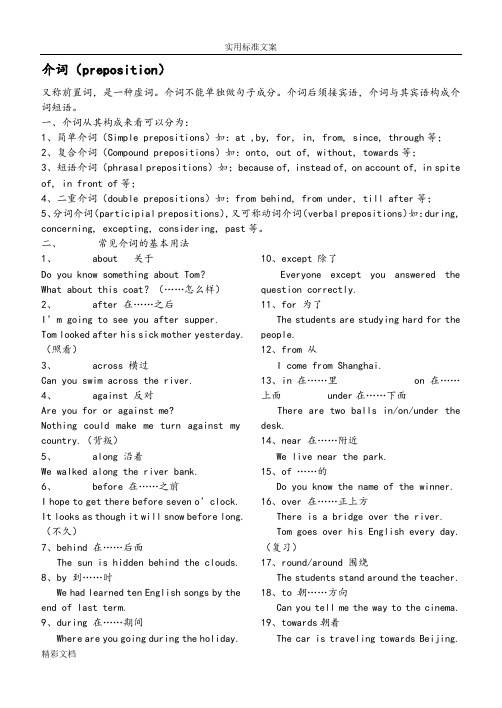
介词(preposition)又称前置词,是一种虚词。
介词不能单独做句子成分。
介词后须接宾语,介词与其宾语构成介词短语。
一、介词从其构成来看可以分为:1、简单介词(Simple prepositions)如:at ,by, for, in, from, since, through等;2、复合介词(Compound prepositions)如:onto, out of, without, towards等;3、短语介词(phrasal prepositions)如;because of, instead of, on account of, in spite of, in front of等;4、二重介词(double prepositions)如:from behind, from under, till after等;5、分词介词(participial prepositions),又可称动词介词(verbal prepositions)如:during, concerning, excepting, considering, past等。
二、常见介词的基本用法1、 about 关于Do you know something about Tom?What about this coat?(……怎么样)2、 after 在……之后I’m going to see you after supper. Tom looked after his sick mother yesterday.(照看)3、 across 横过Can you swim across the river.4、 against 反对Are you for or against me?Nothing could make me turn against my country.(背叛)5、 along 沿着We walked along the river bank.6、 before 在……之前I hope to get there before seven o’clock. It looks as though it will snow before long.(不久)7、behind 在……后面The sun is hidden behind the clouds.8、by 到……时We had learned ten English songs by the end of last term.9、during 在……期间Where are you going during the holiday. 10、except 除了Everyone except you answered the question correctly.11、for 为了The students are studying hard for the people.12、from 从I come from Shanghai.13、in 在……里 on 在……上面 under在……下面There are two balls in/on/under the desk.14、near 在……附近We live near the park.15、of ……的Do you know the name of the winner.16、over 在……正上方There is a bridge over the river.Tom goes over his English every day.(复习)17、round/around 围绕The students stand around the teacher.18、to 朝……方向Can you tell me the way to the cinema.19、towards朝着The car is traveling towards Beijing.20、with 和……一起me?Would you like to go to the cinema with学习这些介词时可以先记住它的汉语意思,然后参照例句来加深理解,并在今后的学习中加以灵活运用。
介词考点解析(Word版附答案)
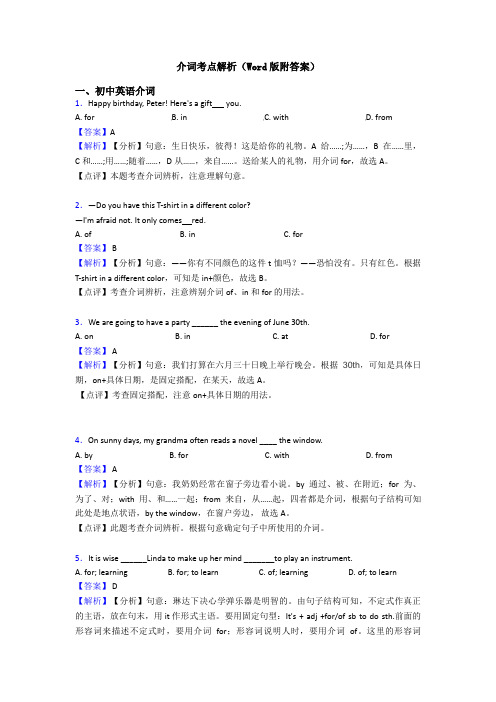
介词考点解析(Word版附答案)一、初中英语介词1.Happy birthday, Peter! Here's a gift you.A. forB. inC. withD. from【答案】A【解析】【分析】句意:生日快乐,彼得!这是给你的礼物。
A给……;为……,B 在……里,C和……;用……;随着……,D从……,来自……。
送给某人的礼物,用介词for,故选A。
【点评】本题考查介词辨析,注意理解句意。
2.—Do you have this T-shirt in a different color?—I'm afraid not. It only comes red.A. ofB. inC. for【答案】 B【解析】【分析】句意:——你有不同颜色的这件t恤吗?——恐怕没有。
只有红色。
根据T-shirt in a different color,可知是in+颜色,故选B。
【点评】考查介词辨析,注意辨别介词of、in和for 的用法。
3.We are going to have a party ______ the evening of June 30th.A. onB. inC. atD. for【答案】 A【解析】【分析】句意:我们打算在六月三十日晚上举行晚会。
根据30th,可知是具体日期,on+具体日期,是固定搭配,在某天,故选A。
【点评】考查固定搭配,注意on+具体日期的用法。
4.On sunny days, my grandma often reads a novel ____ the window.A. byB. forC. withD. from【答案】 A【解析】【分析】句意:我奶奶经常在窗子旁边看小说。
by通过、被、在附近;for为、为了、对;with用、和……一起;from 来自,从……起,四者都是介词,根据句子结构可知此处是地点状语,by the window,在窗户旁边,故选A。
(完整word版)初中英语介词用法详解与练习
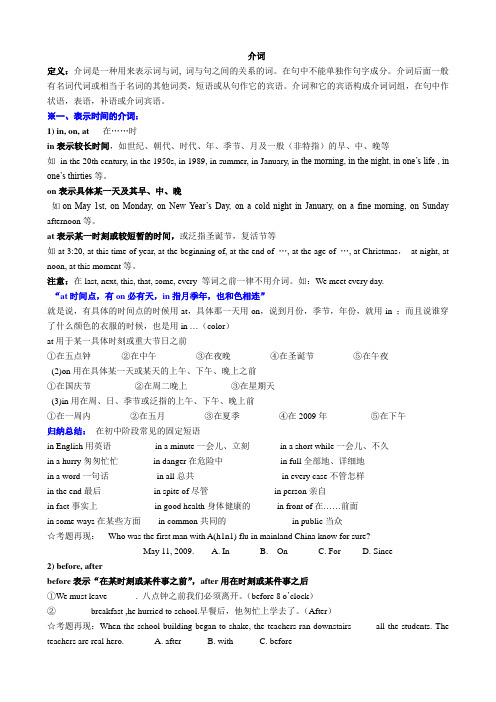
介词定义:介词是一种用来表示词与词, 词与句之间的关系的词。
在句中不能单独作句字成分。
介词后面一般有名词代词或相当于名词的其他词类,短语或从句作它的宾语。
介词和它的宾语构成介词词组,在句中作状语,表语,补语或介词宾语。
※一、表示时间的介词:1) in, on, at 在……时in表示较长时间,如世纪、朝代、时代、年、季节、月及一般(非特指)的早、中、晚等如in the 20th century, in the 1950s, in 1989, in summer, in January, in the morning, in the night, in one’s life , in one’s thirties等。
on表示具体某一天及其早、中、晚如on May 1st, on Monday, on New Year’s Day, on a cold night in January, on a fine morning, on Sunday afternoon等。
at表示某一时刻或较短暂的时间,或泛指圣诞节,复活节等如at 3:20, at this time of year, at the beginning of, at the end of …, at the age of …, at Christmas,at night, at noon, at this moment等。
注意:在last, next, this, that, some, every 等词之前一律不用介词。
如:We meet every day.“at时间点,有on必有天,in指月季年,也和色相连”就是说,有具体的时间点的时候用at,具体那一天用on,说到月份,季节,年份,就用in ;而且说谁穿了什么颜色的衣服的时候,也是用in …(color)at用于某一具体时刻或重大节日之前①在五点钟______ ②在中午________ ③在夜晚________ ④在圣诞节________ ⑤在午夜_________(2)on用在具体某一天或某天的上午、下午、晚上之前①在国庆节_________ ②在周二晚上_________ ③在星期天_________(3)in用在周、日、季节或泛指的上午、下午、晚上前①在一周内________ ②在五月________ ③在夏季________ ④在2009年_________ ⑤在下午________ 归纳总结:在初中阶段常见的固定短语in English用英语in a minute一会儿、立刻in a short while一会儿、不久in a hurry匆匆忙忙in danger在危险中in full全部地、详细地in a word一句话in all总共in every case不管怎样in the end最后in spite of尽管in person亲自in fact事实上in good health身体健康的in front of在……前面in some ways在某些方面in common共同的in public当众☆考题再现:---Who was the first man with A(h1n1) flu in mainland China know for sure?---________May 11, 2009. A. In B. On C. For D. Since2) before, afterbefore表示“在某时刻或某件事之前”,after用在时刻或某件事之后①We must leave ______. 八点钟之前我们必须离开。
(完整版)初中英语语法介词用法讲解与练习
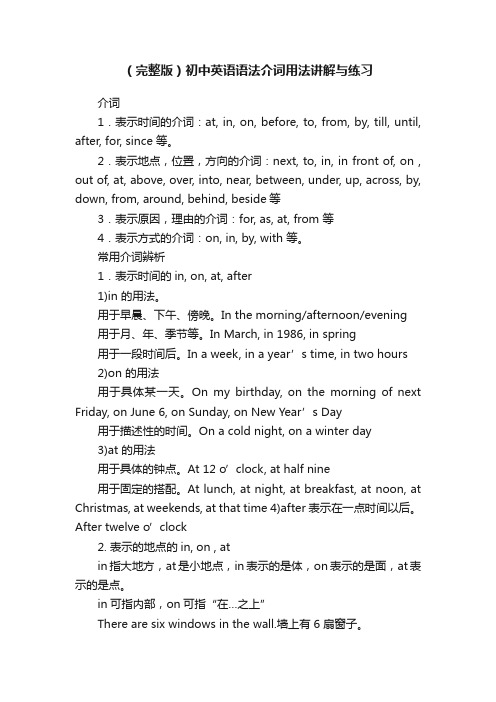
(完整版)初中英语语法介词用法讲解与练习介词1.表示时间的介词:at, in, on, before, to, from, by, till, until, after, for, since 等。
2.表示地点,位置,方向的介词:next, to, in, in front of, on , out of, at, above, over, into, near, between, under, up, across, by, down, from, around, behind, beside等3.表示原因,理由的介词:for, as, at, from 等4.表示方式的介词:on, in, by, with 等。
常用介词辨析1.表示时间的in, on, at, after1)in 的用法。
用于早晨、下午、傍晚。
In the morning/afternoon/evening用于月、年、季节等。
In March, in 1986, in spring用于一段时间后。
In a week, in a year’s time, in two hours2)on 的用法用于具体某一天。
On my birthday, on the morning of next Friday, on June 6, on Sunday, on New Year’s Day用于描述性的时间。
On a cold night, on a winter day3)at 的用法用于具体的钟点。
At 12 o’clock, at half nine用于固定的搭配。
At lunch, at night, at breakfast, at noon, at Christmas, at weekends, at that time 4)after 表示在一点时间以后。
After twelve o’clock2. 表示的地点的in, on , atin指大地方,at是小地点,in表示的是体,on表示的是面,at表示的是点。
(完整word版)中考介词专题讲解及练习
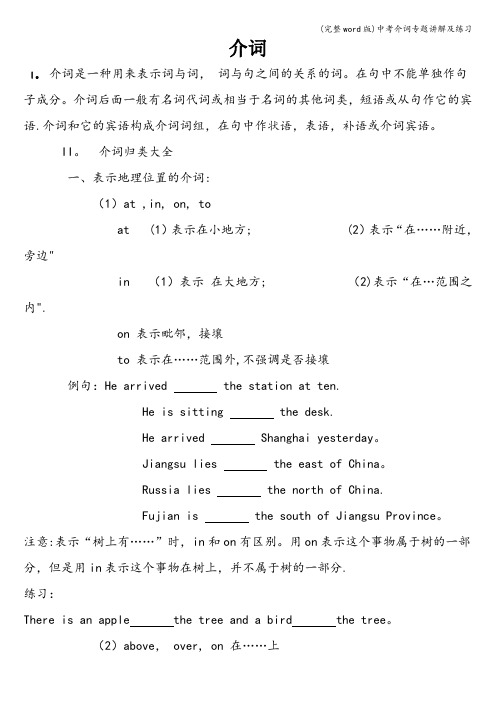
介词I。
介词是一种用来表示词与词,词与句之间的关系的词。
在句中不能单独作句子成分。
介词后面一般有名词代词或相当于名词的其他词类,短语或从句作它的宾语.介词和它的宾语构成介词词组,在句中作状语,表语,补语或介词宾语。
II。
介词归类大全一、表示地理位置的介词:(1)at ,in, on, toat (1)表示在小地方; (2)表示“在……附近,旁边"in (1)表示在大地方; (2)表示“在…范围之内".on 表示毗邻,接壤to 表示在……范围外,不强调是否接壤例句:He arrived the station at ten.He is sitting the desk.He arrived Shanghai yesterday。
Jiangsu lies the east of China。
Russia lies the north of China.Fujian is the south of Jiangsu Province。
注意:表示“树上有……”时,in和on有区别。
用on表示这个事物属于树的一部分,但是用in表示这个事物在树上,并不属于树的一部分.练习:There is an apple the tree and a bird the tree。
(2)above, over, on 在……上above 指在……上方,不强调是否垂直,与 below相对;over指垂直的上方,与under相对,但over与物体有一定的空间,不直接接触。
on表示某物体上面并与之接触。
例句:The bird is flying my head。
There is a bridge the river。
He put his watch the desk。
(3)below, under 在……下面under表示在…正下方below表示在……下,不一定在正下方例句 There is a cat the table。
【英语】 介词练习题(含答案)(word)1
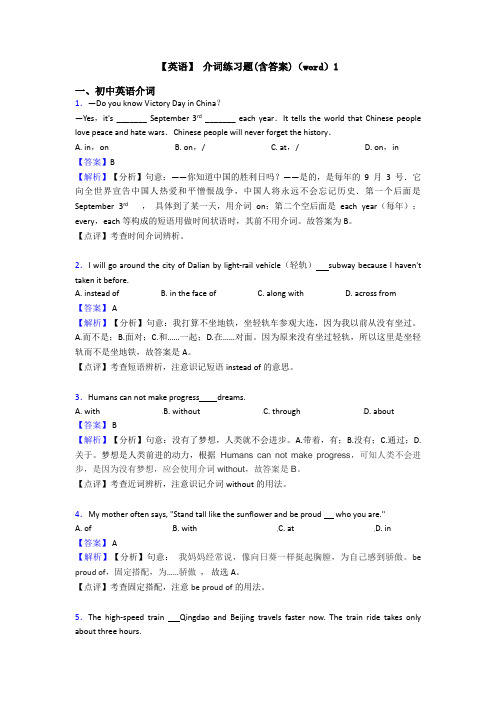
【英语】介词练习题(含答案)(word)1一、初中英语介词1.—Do you know Victory Day in China?—Yes,it's _______ September 3rd_______ each year.It tells the world that Chinese people love peace and hate wars.Chinese people will never forget the history.A. in,onB. on,/C. at,/D. on,in【答案】B【解析】【分析】句意:——你知道中国的胜利日吗?——是的,是每年的9月3号.它向全世界宣告中国人热爱和平憎恨战争,中国人将永远不会忘记历史.第一个后面是September 3rd ,具体到了某一天,用介词on;第二个空后面是each year(每年);every,each等构成的短语用做时间状语时,其前不用介词。
故答案为B。
【点评】考查时间介词辨析。
2.I will go around the city of Dalian by light-rail vehicle(轻轨) subway because I haven't taken it before.A. instead ofB. in the face ofC. along withD. across from【答案】 A【解析】【分析】句意:我打算不坐地铁,坐轻轨车参观大连,因为我以前从没有坐过。
A.而不是;B.面对;C.和……一起;D.在……对面。
因为原来没有坐过轻轨,所以这里是坐轻轨而不是坐地铁,故答案是A。
【点评】考查短语辨析,注意识记短语instead of的意思。
3.Humans can not make progress dreams.A. withB. withoutC. throughD. about【答案】 B【解析】【分析】句意:没有了梦想,人类就不会进步。
初中英语介词语法知识点总结(讲义及答案)
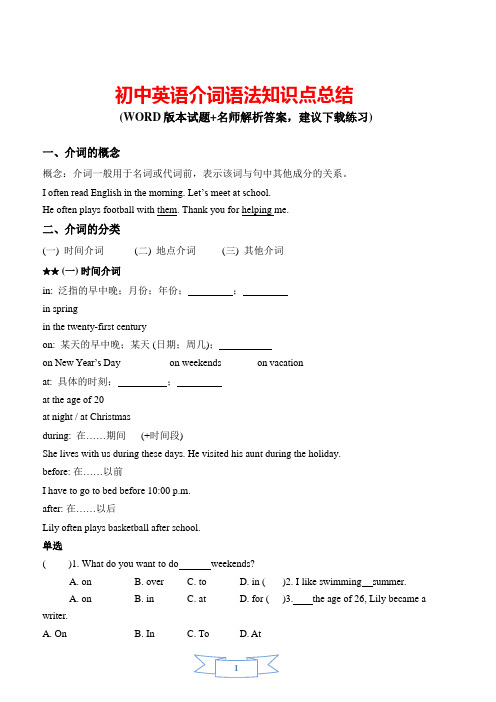
初中英语介词语法知识点总结(WORD版本试题+名师解析答案,建议下载练习)一、介词的概念概念:介词一般用于名词或代词前,表示该词与句中其他成分的关系。
I often read English in the morning. Let’s meet at school.He often plays football with them. Thank you for helping me.二、介词的分类(一) 时间介词(二) 地点介词(三) 其他介词★★ (一) 时间介词in: 泛指的早中晚;月份;年份;;in springin the twenty-first centuryon: 某天的早中晚;某天 (日期;周几);on New Year’s Day on weekends on vacationat: 具体的时刻;;at the age of 20at night / at Christmasduring: 在……期间(+时间段)She lives with us during these days. He visited his aunt during the holiday.before: 在……以前I have to go to bed before 10:00 p.m.after: 在……以后Lily often plays basketball after school.单选( )1. What do you want to do weekends?A. onB. overC. toD. in ( )2. I like swimming summer.A. onB. inC. atD. for ( )3. the age of 26, Lily became a writer.A. OnB. InC. ToD. At( )4. Jim learned to drive ___ the holiday.A. atB. duringC. toD. for( )5. He went to Shanghai July 7, 2013 and came backa cold morning last year.A. in; onB. on; inC. on; onD. in; in( )6. My mom often tells me to go back home dark(黄昏).A. afterB. toC. beforeD. for( )7. A lot of people are here _ vacation every year.A. ofB. onC. atD. with★★ (二) 地点介词1.地点介词 at, in, onat: “在……”(表一个点或小地方)at home at Mr. Cool’s Clothes Storeat the pool at Central Parkin: “在……里” (表一个范围或大地方) in China in Beijing in the water in the parkon: “在……上” (表一个表面,并接触) on the floor on the wall 对比这三个句子:They stood at the door and waited.他们站在门口等着。
初一介词详解及练习题(专项训练)

5.介词+名词+介词in front of; at the age of; at the end of
6.介词+动名词短语after leaving school; after finishing it
7.介词+代词for her; from each other; after him
8.其他词+介词instead of; because of; according to
We went there in six days. (过去时中in表....时间内)
We went there after six days. (过去时中after表....时间后)
We often do our homework after school. (固定词组, after class; after supper等)
A. above B. against C. for
11. What a nice day! We should go sightseeing _____ watching TV in the hotel.
A. because of B. instead of C. together with
12. Your coat looks very nice. What’s it made ______?
2.There is a white car ______ our school.
3.Many shops are ______ our home.
4._______ our city there is a river.
练习二:
最新初中必备英语介词技巧全解及练习题(含答案)
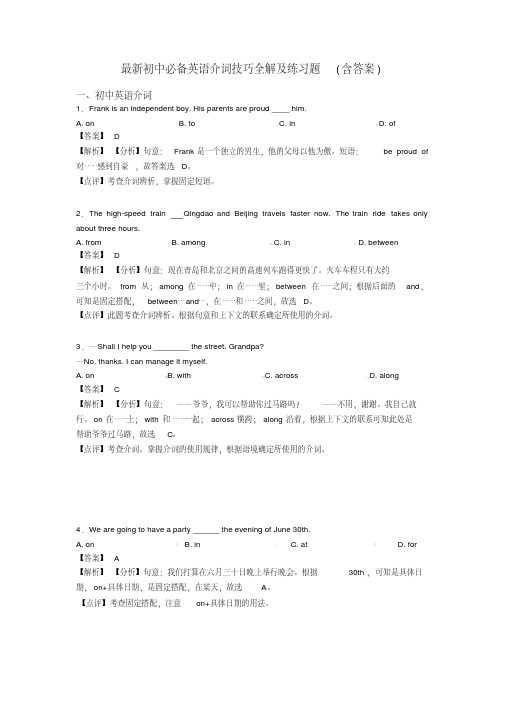
18. In the picture, he sits ______me, looking very happy.
A. beside
B. among
C. up
【答案】 A
D. through
【解析】 【分析】句意:在这张照片中,他坐在我的旁边,看上去非常高兴。
A. beside
在······旁边; B. among 在 ······中 ; C. up 向上 ;D. through 穿过。根据常理推断,照片中他
A. at 【答案】 D
B. by
C. over
D. under
【解析】 【分析】句意:弗兰克在水下屏住呼吸,在游泳池中找他的戒指。
A.在 ……, B.通
过某种方式; C.高于; D.在 ……下,面。根据 Frank held his breath 和 in the swimming ,可
知一定是在水下,应使用介词 under ,故答案是 D 。
for,故选 A。
12. An earthquake happened in Songyuan, Jilin________ the morning of May28, 2018.
A. on
B. in
C. at
【答案】 A
【解析】 【分析】句意: 2018 年 5 月 28 日早晨,吉林松原发生了地震。 A. on 表示具体的
in 。
15. Did you read your favorite books _____ April 23? It was World Book Day.
A. for
B. at
C. on
D. in
【答案】 C
【解析】 【分析】句意:你在四月二十三读了你最喜欢的书了吗?那天是世界读书日。在
初中英语语法讲解与练习
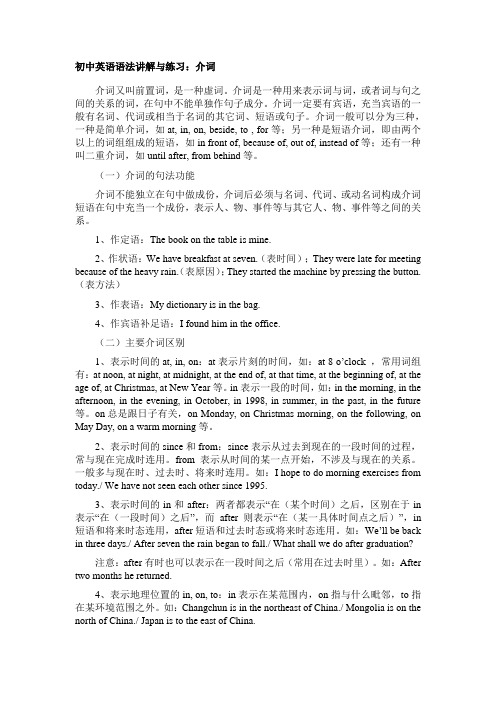
初中英语语法讲解与练习:介词介词又叫前置词,是一种虚词。
介词是一种用来表示词与词,或者词与句之间的关系的词,在句中不能单独作句子成分。
介词一定要有宾语,充当宾语的一般有名词、代词或相当于名词的其它词、短语或句子。
介词一般可以分为三种,一种是简单介词,如at, in, on, beside, to , for等;另一种是短语介词,即由两个以上的词组组成的短语,如in front of, because of, out of, instead of等;还有一种叫二重介词,如until after, from behind等。
(一)介词的句法功能介词不能独立在句中做成份,介词后必须与名词、代词、或动名词构成介词短语在句中充当一个成份,表示人、物、事件等与其它人、物、事件等之间的关系。
1、作定语:The book on the table is mine.2、作状语:We have breakfast at seven.(表时间);They were late for meeting because of the heavy rain.(表原因);They started the machine by pressing the button.(表方法)3、作表语:My dictionary is in the bag.4、作宾语补足语:I found him in the office.(二)主要介词区别1、表示时间的at, in, on:at表示片刻的时间,如:at 8 o’clock ,常用词组有:at noon, at night, at midnight, at the end of, at that time, at the beginning of, at the age of, at Christmas, at New Year等。
in表示一段的时间,如:in the morning, in the afternoon, in the evening, in October, in 1998, in summer, in the past, in the future 等。
初中英语语法基础——介词专题讲解 (附同步练习试题)
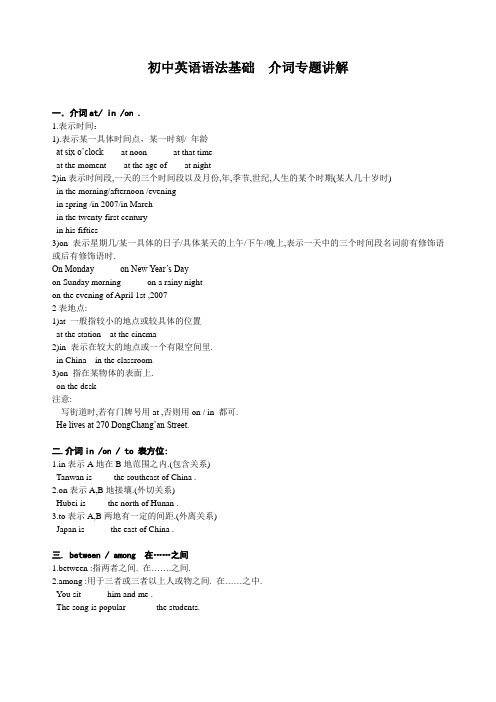
初中英语语法基础介词专题讲解一.介词at/ in /on .1.表示时间:1).表示某一具体时间点,某一时刻/ 年龄at six o’clock at noon at that timeat the moment at the age of at night2)in表示时间段,一天的三个时间段以及月份,年,季节,世纪,人生的某个时期(某人几十岁时)in the morning/afternoon /eveningin spring /in 2007/in Marchin the twenty-first centuryin his fifties3)on表示星期几/某一具体的日子/具体某天的上午/下午/晚上,表示一天中的三个时间段名词前有修饰语或后有修饰语时.On Monday on New Year’s Dayon Sunday morning on a rainy nighton the evening of April 1st ,20072表地点:1)at 一般指较小的地点或较具体的位置at the station at the cinema2)in 表示在较大的地点或一个有限空间里.in China in the classroom3)on 指在某物体的表面上.on the desk注意:写街道时,若有门牌号用at ,否则用on / in 都可.He lives at 270 DongChang’an Street.二.介词in /on / to 表方位:1.in表示A地在B地范围之内.(包含关系)Tanwan is ____ the southeast of China .2.on表示A,B地接壤.(外切关系)Hubei is ____ the north of Hunan .3.to表示A,B两地有一定的间距.(外离关系)Japan is _____ the east of China .三. between / among 在……之间1.between :指两者之间. 在…….之间.2.among :用于三者或三者以上人或物之间. 在……之中.You sit _____ him and me .The song is popular ______ the students.四.after / in 在……之后 before / in 在……之前1. after1)after + 时间段. 表示以过去某一时刻为起点的一段时间之后, 用于过去时.2)after 作介词. after doing sth.2.in +一段时间. 表示说话时或以现在为起点的将来一段时间之后.用于将来时.He came back ______ two days .He will go home___finishing his homework .He will come back _____ two days .3. before 多用于时间点或一件事之前发生,即“先于……;在……之前”He left the office bofore I got there. I’ll be back before five o’clock.4. ago 时间段+ ago 表示“多久之前”时态通常用:一般过去时I met Tom two days ago.五.with / in / by 表示“用……”1.with 表示“用…” 一般指有形的工具/ 手段/ 人体器官.He cut the apple into halves ____ a knife .注: with 表伴随, “带有,含有”He came in _____ a big smile on his face .2.in表示用某种语言,方式,途径. 或书写/绘画所用的材料. 也可表交通方式.Can you say it _____English ?He wrote a letter ____ blue ink .3.by表示乘坐交通工具, 表示方式,方法I study for a test _____ working with a group .He makes a living ____ selling newspapers .注意: 同义词组1).by phone = on the phone2).by car = in a car3).in pen = with a pen = with pens六.across / through / over / by 经过1.across 指横穿,穿过. 表示动作从某一物体表面上经过.2.through 指穿过,透过,表示从某一物体空间内通过.3.over 表示从某人或某物的上空经过或越过,不与表面接触.4.by 表示从某人/某物的旁边经过.Can you swim ______ the river ?the elephant is so big that it can’t go _____ the gate .I don’t think anyone can jump ___ the fenc e.I walked _____ the bank of China yesterday .七.in front of / in the front of1.in the front of 表示在…….内部的前面2.in front of 表示在……外面的前面There is a desk in _____ front of our classroom .There is a big tree in _____ front of our classroom.八.其它介词的用法:1.at的其它用法.1).表示“从事或正在做某事”,其后加的名词往往不加冠词.She is at work now = She is working now .2)at表示“价格或速度”The train ran at 120 kilometers an hour .2.in的其它用法:1)in表示“在……方面”词组:do well in = be good atbe weak in2)in 表示“穿着”后接表颜色的词或衣服.词组: be in +衣服= be wearing +衣服3)in作副词, “在家” = at home3.like 的用法:1).像/和……一样. 常与系动词连用.词组: look like sound like2).与what 连用, “是什么样子, 怎样”.What is he like ? He is kind .4.off的用法:1).从……下来, 脱离某物体.词组: fall off2). “休假”通常放在时间名词之后.词组: have +时间+ offHe has n’t had a night off for two hours .5.except / besides1).except 除了…….之外, 都……. . 不包括在范围之内.注: nothing but … 除了……之外,什么也没有.2).besides除了……之外,还有…… . 包括在范围之内.We all went swimming ______ Lucy .There is _______ a letter in the box .We study Japanese and French____ English .6.with / without1).with具有,含有反义词: without 没有词组: with the help of = with one’s help =because of = thanks towithout one’s help2).without 的用法:A).without + sb./ sth. 没有某人或某物B).without + doing sth . He lef t here without____(say ) “Goodbye”to usC). without sth 常与if 引导的否定的条件句.If there is no water , we can’t live .= We can’t live ______ _______ .7.on the tree /in the treeon the tree 表示“树上本身长的东西” 在树上.in the tree 表示“外界的物体进入树中” 人或物在树上.There are some apples _____ the tree .There is a boy ____ the tree.8.表示“数量的介词”about , round around , over1). about , round around表示“大约……”2).over 表示“超过”= more than.9.inside / outsideInside 在……里面------反义词:outside在….外面10.in the wall /on the wallin the wall 表示“门窗在墙上” on the wall 表示“某东西张贴或挂在墙上”九.不用介词的情况:1).当时间状语为: tonight, today, yesterday, tomorrow 等时,不用介词. What are you going to do tonight ?2).含有this, that, these, those, last, next, every/each day等时间状语.He went to Wuhan last week . I drink milk every day.3).以all 开头的时间状语前面不用介词.He has worked all day .4).以some ,any, one 等构成的时间状语前不用介词.He met a bad man one cold morning. = He met a bad man on a cold morning.介词专题小测:一、单项选择题。
(完整word版)初中英语介词专项讲解及练习(包含答案)
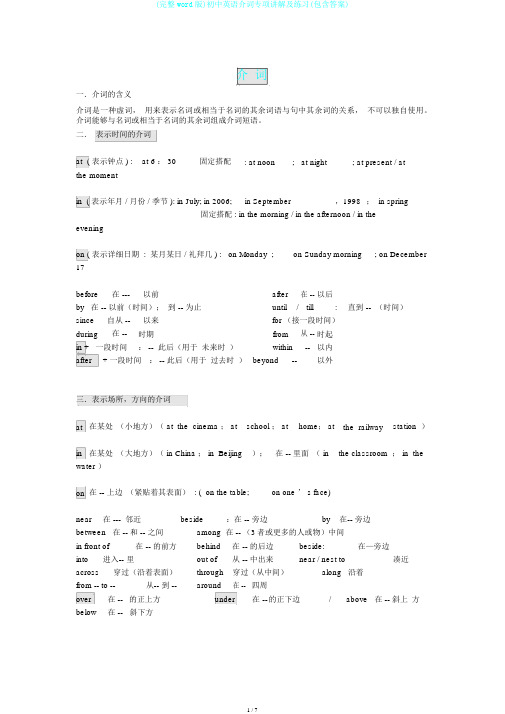
介词一.介词的含义介词是一种虚词,用来表示名词或相当于名词的其余词语与句中其余词的关系,不可以独自使用。
介词能够与名词或相当于名词的其余词组成介词短语。
二.表示时间的介词at ( 表示钟点 ) :at 6 : 30固定搭配: at noon;at night; at present / atthe momentin ( 表示年月 / 月份 / 季节 ): in July; in 2006;in September,1998; in spring固定搭配 : in the morning / in the afternoon / in theeveningon ( 表示详细日期 : 某月某日 / 礼拜几 ) : on Monday ;on Sunday morning; on December 17before在 ---以前after在 --以后by 在 -- 以前(时间);到 -- 为止until/till:直到 -- (时间)since自从 --以来for (接一段时间)during在 --时期from从 --时起in + 一段时间: -- 此后(用于未来时)within--以内after+ 一段时间: -- 此后(用于过去时) beyond--以外三.表示场所,方向的介词at在某处(小地方)( at the cinema ; at school ; at home; at the railway station )in在某处(大地方)( in China ; in Beijing);在 -- 里面( in the classroom; in the water )on在 -- 上边(紧贴着其表面) : ( on the table;on one ’ s face)near在 --- 邻近beside:在 -- 旁边by在-- 旁边between 在 -- 和 -- 之间among 在 -- (3者或更多的人或物)中间in front of在 -- 的前方behind在 -- 的后边beside:在—旁边into进入-- 里out of从 -- 中出来near / nest to凑近across穿过(沿着表面)through 穿过(从中间)along 沿着from --to --从-- 到 --around在 --四周over在 --的正上方under在 --的正下边/above 在 -- 斜上方below在 --斜下方四.其余介in 用(某种言),衣着(某种色的衣服)about大;对于as 像 -- (接句子);正如 --;like像--(接)with和 -- 起;用--without没有--by 通(某种方式或手段);乘坐by bus ( train /plane /ship /bikefrom来自)on foot---五.重要介辨析(1) on, over 与 aboveOn 在⋯⋯上边与物体表面有接触面Over 在⋯⋯上方垂直正上方,表示“超越,覆盖”Above 在⋯⋯上方“在⋯⋯ (偏)上方”,表示二者不接触比如:There is a bag on the desk.The lamp is over the table.The heaven is above us.(天在上。
(word版)七年级常用介词用法和练习(含答案),文档
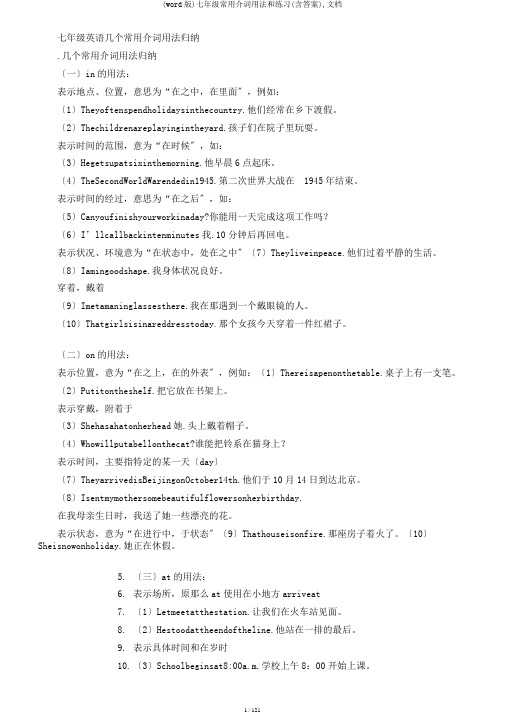
七年级英语几个常用介词用法归纳.几个常用介词用法归纳〔一〕in的用法:表示地点、位置,意思为“在之中,在里面〞,例如:〔1〕Theyoftenspendholidaysinthecountry.他们经常在乡下渡假。
〔2〕Thechildrenareplayingintheyard.孩子们在院子里玩耍。
表示时间的范围,意为“在时候〞,如:〔3〕Hegetsupatsixinthemorning.他早晨6点起床。
〔4〕TheSecondWorldWarendedin1945.第二次世界大战在1945年结束。
表示时间的经过,意思为“在之后〞,如:〔5〕Canyoufinishyourworkinaday?你能用一天完成这项工作吗?〔6〕I’llcallbackintenminutes我.10分钟后再回电。
表示状况、环境意为“在状态中,处在之中〞〔7〕Theyliveinpeace.他们过着平静的生活。
〔8〕Iamingoodshape.我身体状况良好。
穿着,戴着〔9〕Imetamaninglassesthere.我在那遇到一个戴眼镜的人。
〔10〕Thatgirlsisinareddresstoday.那个女孩今天穿着一件红裙子。
〔二〕on的用法:表示位置,意为“在之上,在的外表〞,例如:〔1〕Thereisapenonthetable.桌子上有一支笔。
〔2〕Putitontheshelf.把它放在书架上。
表示穿戴,附着于〔3〕Shehasahatonherhead她.头上戴着帽子。
〔4〕Whowillputabellonthecat?谁能把铃系在猫身上?表示时间,主要指特定的某一天〔day〕〔7〕TheyarrivedisBeijingonOctober14th.他们于10月14日到达北京。
〔8〕Isentmymothersomebeautifulflowersonherbirthday.在我母亲生日时,我送了她一些漂亮的花。
完整版)初中介词和介词短语专题讲解(含练习)

完整版)初中介词和介词短语专题讲解(含练习)介词及介词短语介词是一种虚词,用来表示名词或相当于名词的其它词语在句中的关系,不能单独使用。
介词可与名词或相当于名词的其它词构成介词短语。
介词短语可在句中作定语、状语、表语和宾语补足语。
例如:那个男孩子是XXX的兄弟。
(定语)女孩子两小时后回来。
(状语)介词分为简单介词和复合介词。
常用的简单介词有at、in、on、about、across、before、beside、for、to、without等。
复合介词如by means of、along with、because of、in front of、instead of等。
表时间的介词有以下几种用法:1)at。
in。
on表示时间点用at。
例如:六点钟、中午、午夜。
表示在某个世纪、某年、某月、某个季节以及早晨、上午、下午、晚上时,用in。
例如:19世纪、2002年、五月、冬天、早上、下午等。
表示具体的某一天和某一天的上午、下午、晚上时,用on。
例如:星期一、7月1日、星期日早上等。
2)since。
after由since和XXX引导的词组都可表示从过去某一点开始的时段,但since词组表示的时段一直延续到说话的时刻,因而往往要与现在完成时连用。
而after词组所表示的时段纯系过去,因而要与一般过去时连用。
例如:我自去年夏天以来就没有收到他的消息。
(现在完成时)五天后,那个男孩回来了。
(一般过去时)3)in。
afterin与将来时态连用时,表示“过多长时间以后”的意思,后面跟表示一段时间的词语。
after与将来时态连用时,后面只能跟表示时间点的词语。
文章中介绍了表示时间和地点的常用介词的用法辨析。
当表示一段时间时,应该使用after与过去时态连用,后面跟表示一段时间的词语。
例如:He returned after a month。
当表示地点时,at一般指小地方,in一般指大地方或某个范围之内,on往往表示“在某个物体的表面”。
(完整)初中英语介词用法详解与练习.
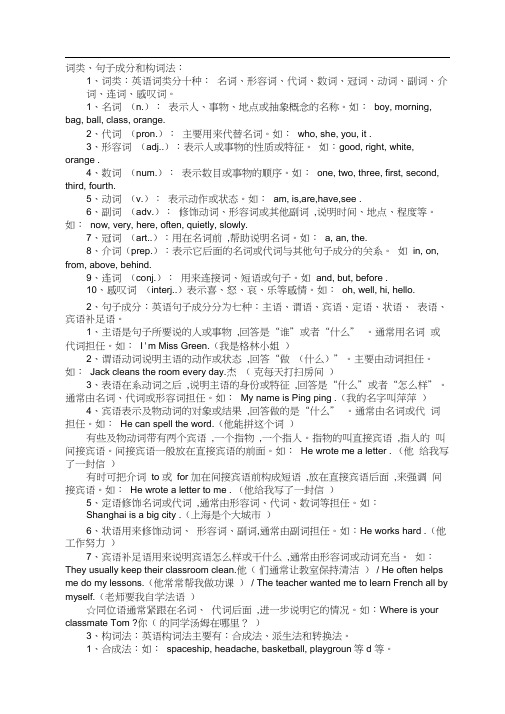
词类、句子成分和构词法:1、词类:英语词类分十种:名词、形容词、代词、数词、冠词、动词、副词、介词、连词、感叹词。
1、名词(n.):表示人、事物、地点或抽象概念的名称。
如:boy, morning, bag, ball, class, orange.2、代词(pron.):主要用来代替名词。
如:who, she, you, it .3、形容词(adj..):表示人或事物的性质或特征。
如:good, right, white, orange .4、数词(num.):表示数目或事物的顺序。
如:one, two, three, first, second, third, fourth.5、动词(v.):表示动作或状态。
如:am, is,are,have,see .6、副词(adv.):修饰动词、形容词或其他副词,说明时间、地点、程度等。
如:now, very, here, often, quietly, slowly.7、冠词(art..):用在名词前,帮助说明名词。
如:a, an, the.8、介词(prep.):表示它后面的名词或代词与其他句子成分的关系。
如in, on, from, above, behind.9、连词(conj.):用来连接词、短语或句子。
如and, but, before .10、感叹词(interj..)表示喜、怒、哀、乐等感情。
如:oh, well, hi, hello.2、句子成分:英语句子成分分为七种:主语、谓语、宾语、定语、状语、表语、宾语补足语。
1、主语是句子所要说的人或事物,回答是“谁”或者“什么” 。
通常用名词或代词担任。
如:I'm Miss Green.(我是格林小姐)2、谓语动词说明主语的动作或状态,回答“做(什么)”。
主要由动词担任。
如:Jack cleans the room every day.杰(克每天打扫房间)3、表语在系动词之后,说明主语的身份或特征,回答是“什么”或者“怎么样”。
(完整版)介词的用法及习题
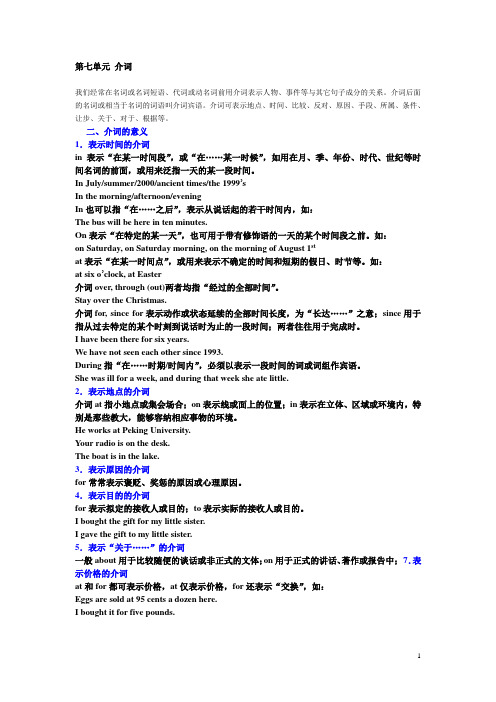
第七单元介词我们经常在名词或名词短语、代词或动名词前用介词表示人物、事件等与其它句子成分的关系。
介词后面的名词或相当于名词的词语叫介词宾语。
介词可表示地点、时间、比较、反对、原因、手段、所属、条件、让步、关于、对于、根据等。
二、介词的意义1.表示时间的介词in表示“在某一时间段”,或“在……某一时候”,如用在月、季、年份、时代、世纪等时间名词的前面,或用来泛指一天的某一段时间。
In July/summer/2000/ancient times/the 1999’sIn the morning/afternoon/eveningIn也可以指“在……之后”,表示从说话起的若干时间内,如:The bus will be here in ten minutes.On表示“在特定的某一天”,也可用于带有修饰语的一天的某个时间段之前。
如:on Saturday, on Saturday morning, on the morning of August 1stat表示“在某一时间点”,或用来表示不确定的时间和短期的假日、时节等。
如:at six o’clock, at Easter介词over, through (out)两者均指“经过的全部时间”。
Stay over the Christmas.介词for, since for表示动作或状态延续的全部时间长度,为“长达……”之意;since用于指从过去特定的某个时刻到说话时为止的一段时间;两者往往用于完成时。
I have been there for six years.We have not seen each other since 1993.During指“在……时期/时间内”,必须以表示一段时间的词或词组作宾语。
She was ill for a week, and during that week she ate little.2.表示地点的介词介词at指小地点或集会场合;on表示线或面上的位置;in表示在立体、区域或环境内,特别是那些教大,能够容纳相应事物的环境。
- 1、下载文档前请自行甄别文档内容的完整性,平台不提供额外的编辑、内容补充、找答案等附加服务。
- 2、"仅部分预览"的文档,不可在线预览部分如存在完整性等问题,可反馈申请退款(可完整预览的文档不适用该条件!)。
- 3、如文档侵犯您的权益,请联系客服反馈,我们会尽快为您处理(人工客服工作时间:9:00-18:30)。
介词定义:介词是一种用来表示词与词, 词与句之间的关系的词。
在句中不能单独作句字成分。
介词后面一般有名词代词或相当于名词的其他词类,短语或从句作它的宾语。
介词和它的宾语构成介词词组,在句中作状语,表语,补语或介词宾语。
※一、表示时间的介词:1) in, on, at 在……时in表示较长时间,如世纪、朝代、时代、年、季节、月及一般(非特指)的早、中、晚等如in the 20th century, in the 1950s, in 1989, in summer, in January, in the morning, in the night, in one’s life , in one’s thirties等。
on表示具体某一天及其早、中、晚如on May 1st, on Monday, on New Year’s Day, on a cold night in January, on a fine morning, on Sunday afternoon等。
at表示某一时刻或较短暂的时间,或泛指圣诞节,复活节等如at 3:20, at this time of year, at the beginning of, at the end of …, at the age of …, at Christmas,at night, at noon, at this moment等。
注意:在last, next, this, that, some, every 等词之前一律不用介词。
如:We meet every day.“at时间点,有on必有天,in指月季年,也和色相连”就是说,有具体的时间点的时候用at,具体那一天用on,说到月份,季节,年份,就用in ;而且说谁穿了什么颜色的衣服的时候,也是用in …(color)at用于某一具体时刻或重大节日之前①在五点钟______ ②在中午________ ③在夜晚________ ④在圣诞节________ ⑤在午夜_________(2)on用在具体某一天或某天的上午、下午、晚上之前①在国庆节_________ ②在周二晚上_________ ③在星期天_________(3)in用在周、日、季节或泛指的上午、下午、晚上前①在一周内________ ②在五月________ ③在夏季________ ④在2009年_________ ⑤在下午________ 归纳总结:在初中阶段常见的固定短语in English用英语in a minute一会儿、立刻in a short while一会儿、不久in a hurry匆匆忙忙in danger在危险中in full全部地、详细地in a word一句话in all总共in every case不管怎样in the end最后in spite of尽管in person亲自in fact事实上in good health身体健康的in front of在……前面in some ways在某些方面in common共同的in public当众☆考题再现:---Who was the first man with A(h1n1) flu in mainland China know for sure?---________May 11, 2009. A. In B. On C. For D. Since2) before, afterbefore表示“在某时刻或某件事之前”,after用在时刻或某件事之后①We must leave ______. 八点钟之前我们必须离开。
(before 8 o’clock)②________breakfast ,he hurried to school.早餐后,他匆忙上学去了。
(After)☆考题再现:When the school building began to shake, the teachers ran downstairs _____all the students. The teachers are real hero. A. after B. with C. before3) by, until, till(1)by表示“在……之前,到……为止”You must hand in your homework ______nine o’clock.你必须在9点前交上家庭作业。
(by)(2)till与until都有“直到……”或“直到……为止”之意,till多用于口语,且不能放在句首,till和until用于肯定句时,主句中动词的动作一致延续到till或until后的时间为止;till和until用于否定句时,主句中的动词是瞬间动作,它的动作要到till或until后的时间才发生。
①He can not be back _____January. 直到一月份他才回来。
(till/until)②We waited _____10 o’clock last night. 昨晚我们一直等到10点钟。
(till/until)4) of, about, onof 仅指“关于”人或事物的存在He spoke of the film the other day. He thought of the matter yesterday.about 指“关于”某人或某事物的较详细的情况It’s a book for children about Africa and it’s people.Can you tell me something about yourself?on 指“关于”学术性的或严肃性的,供专门研究用的It’s a textbook on history of China.5) in, after两者都有“在一段时间之后”之意,但“in+时间段”表示时间从现在算起,常用语将来时态;而“after+时间段/时间点”表示的时间从过去算起,多用于过去式。
(1)I will finish the work _____two hours.两个小时后我将完成这项工作。
(2)He returned his hometown _________half an year.半年后他返回了他的故乡。
【考题再现】No hurry. The bus will arrive _______ten minutes.A .at B. for C. in D. by【解析】在将来时中,in用在一段时间之前,表示在一段时间之后。
故选C※二、表示地点的介词:1. 表示方位的介词:in, on, toin表示“在…内”,on表示“与…相邻”,to表示“在…之外,又不相邻”①A is in the northeast of B. ②A is on the west of B. ③B is to the east of A.【考题再现】Taiwan is a beautiful island and it’s _____east of Fujian. A. in B. on C. to【解析】在表示方位时,in表在内部,on表相邻,to表在外部,又不相邻。
台湾在福建的外部,与福建隔海相望。
2. 表示“在…之上或之下”的介词:above, over, on 在……上above 指在……上方,不强调是否垂直,与below相对;over指垂直的上方,与under相对,但over与物体有一定的空间,不直接接触。
on表示某物体上面并与之接触。
The bird is flying above my head. There is a bridge over the river. He put his watch on the desk.3. below, under 在……下面under表示在…正下方below表示在……下,不一定在正下方There is a cat under the table. Please write your name below the line.My pencil-case is _____ Li Lei’s desk. 我的铅笔盒在李磊的课桌上。
There is a bridge _____ the river. 河上有座桥。
The plane is flying _____ the clouds. 飞机在云层上飞行。
Please do not write _____this line. 请不要写在这条线的下面。
The water flows _____ the bridge. 水在桥下流过。
【考题再现】The weather report said that the temperature would fell _____ zero. (在…下面)【解析】表示在温度的上方或下方用above(上)或below(下)4. 表示在某地的介词:at、in、onat—表示较小的地点,in—表示较大的地方,on—表示在一个平面上。
①_____ Shanghai. ②_____ home. ③_____ ground.【考题再现】Tom told me his parents had arrived _____Beijing. A. at B. on C. in D. to【解析】arrive后接两个介词in或at,at接小地方,in接大地方。
北京是大地方,5. 表示“前、后”的介词⑴in front of ,in the front of,before 表示“在…之前”in front of = before表示“在某一范围之外的前面”;in the front of表示“在某一范围之内的前部”①Tom is short and always sits _____ the classroom. 汤姆很矮,一直坐在教室的前面。
②There is a tree _____ my house. 我的房前有棵大树。
⑵at the back of, behind, after三者均有“在…之后”之意,at the back of是in the front of的反义词,表示“在某一范围之内的后部”,behind是in front of的反义词,表示“在某一范围之外的后面”,after可与behind互换,也可以用于表示运动的词词后面。
①The couples are walking _____their son. 这对夫妇跟在他们的儿子后面散步。
②Your cat is _____the tree. 你的猫躲在树后面。
③There’s a blackboard _____the classroom. 教室后面有块黑板。
